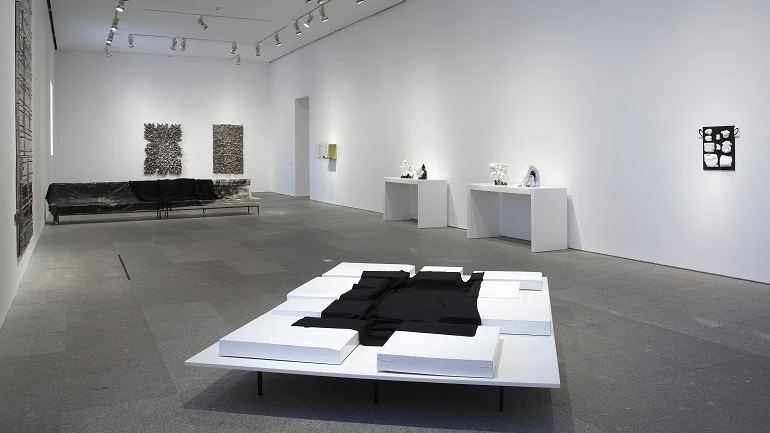Rosemarie Trockel: A Cosmos
Rosemarie Trockel (Schwerte, Germany, 1952) appears in the German art scene, largely dominated by men, in the 1970s. Her art explores various work methods and materials, thus eluding stylistic compartmentalization. Through her creations she questions the categories that legitimise art, social order, gender identities; while exploring constants such as the contrasting conceptions of feminism, the metamorphosis of the subject, interrelations between humans and animals and the environmental impact of our species, the phenomena of fashion, fame, beauty and social icons, the body and also the social construction of the subject.
“Kosmos” was the title that Alexander von Humboldt (1769-1859) gave to his book on the discovery of America. Humboldt, when he attributes the merit of the discovery to Columbus, makes use of the argument of progress as the result of accumulated knowledge. The artist admires Humboldt for his independent and intrepid studies, and she situates him next to other authors she also believes are kindred spirits.
In this collection of objects, Trockel pays attention to lesser known artists, chosen out of the empathy she feels for the frankness and inventiveness with which they look at questions that she too asks herself. Either in another discipline or for independent causes, these nonconformists provide models of selfless and vocational dedication. They include self-taught artists such as James Castle, Judith Scott, Morton Bart¬lett and Manuel Montalvo, who worked in situations of near anonymity. In general, they were solitary artists who worked with humble materials and with great economy of means, and were committed to their search for a singular vision.
Other artefacts in the exhibition come from the sphere of natural history, such as the watercolours painted by Maria Sibylla Merian (1647-1717) about life cycles in entomology or the works of the Spanish botanist, José Celestino Mutis (1732 –1808), whose recognition came late because his studies were never properly published. At the end of the 19th century the Blaschka family created exact glass replicas of plants and marine invertebrates, which were used for research purposes by both amateur and professional naturalists. Today all of them are more appreciated for their aesthetic quality and the curiosity that their work inspires than for the scientific activity they carried out in various fields.
Rosemarie Trockel makes use of all of them, considering them to be exemplary and inspirational in her own work.
With the collaboration of:
![]()

Artists
New Museum, New York (24 October, 2012 - 20 January, 2013); Serpentine Gallery, London (13 February, 2012 - 7 April, 2013)
Goethe Institute
Organised by
Museo Nacional Centro de Arte Reina Sofía
Image gallery






Itinerary
Museo Nacional Centro de Arte Reina Sofía, Madrid
22 May, 2012 - 24 September, 2012
New Museum, Nueva York
24 October, 2012 - 20 January, 2013
Serpentine Gallery, Londres
13 February, 2013 - 7 April, 2013




